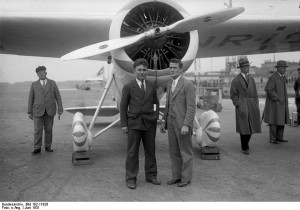
Published on June 23, 2012
On this date in aviation history, Wiley Post and his navigator, Harold Gatty, took off from Roosevelt Field, Long Island, in New York on a bid to make a record-setting flight around the world. Although it seems strange, the record to beat hadn’t been set by an airplane, but rather by the Graf Zeppelin, which had managed the flight two years earlier in just 21 days. Given the unreliability of aircraft, a flight around the world was a major challenge. In fact, Lindbergh’s famous solo flight across the Atlantic to Paris had only just taken place two years earlier. The route to be flown was the equivalent of eight Lindberghs, back to back. Thus, besting the Graf Zeppelin’s record would not be easy.
Yet Wiley Post had an advantage — aircraft design had come a long way in the previous two years. His airplane was a new single-engine Lockheed Vega 5C dubbed the “Winnie Mae.” It was a plane for the record books. Sleek and fast, it looked like it was going 160 mph just sitting on the ground. The Vega was the product of two of the world’s finest aircraft designers, John Knudsen Northrop and Gerrard Vultee (both would later found their own companies). The plane was streamlined with a fuselage construction that employed a novel technique that shaped in two halves together, which were then attached to a set of fuselage ribs. This made a strong and yet extraordinarily lightweight structure that was nothing short of revolutionary.
On June 23rd, Post and Gatty took off in the Winnie Mae and headed north to Harbour Grace in Canada, then across the Atlantic Ocean to Flintshire. He stopped in Hanover and Berlin in Germany before proceeding onward to Moscow in the Soviet Union. From there, he mapped a course that took him over Siberia from Novosibirsk to Irkutsk, Blagoveshchensk and finally Khabarovsk. Then he flew across the Bering Strait to Solomon Beach, near Nome, Alaska. Some repairs were made there to the propeller, allowing him to fly onward to Fairbanks to replace the prop completely. Once that was accomplished, he continued to Edmonton, Canada. Finally, he arrived back in the USA, flying to Cleveland for a quick stop before completing the route by flying back Roosevelt Field. Throughout, Gatty’s navigation was excellent. He landed on July 1st. The entire trip took just 8 days, 15 hours and 51 minutes — not bad for a flight that had covered 15,474 miles — and besting the Graf Zeppelin’s time by nearly 14 days.

Throughout the flight, the newspaper front pages carried stories of his progress. Excitement built as he flew nearer to completing the circumnavigation. Post seemed to spend more time flying than on the ground — although at every stop, he was welcomed as an aviation hero. Finally, back in New York, he was celebrated with a ticker tape parade, just like Lindbergh. In fact, it seemed that New Yorkers were aviation crazy and with every new record, they wanted a parade. Banquets and parties followed. Post and Gatty were even invited to the White House in Washington, DC.
More than any other achievement in his life, Wiley Post’s circumnavigation would ensure that his name was written into aviation history. His aircraft, the Winnie Mae, was later sold to the government for display in the Smithsonian. Their experiences were then written into a best-selling book that was fittingly entitled, Around the World in Eight Days, a tip of the hat to Jules Verne’s book where the adventurer completes the journey in 80 days by ship, rail and the other less “modern” transportation means of Verne’s time. While it is easy to imagine that flights like Post’s were glory-seeking outings, all the more so given the celebrity that resulted, each new record advanced the reach of aviation, bringing new capabilities for the betterment of the world.
One More Bit of Aviation Trivia
The Lockheed Vega would turn out to be one of the most record-setting designs of its time. It was Amelia Earhart’s chosen airplane for her solo flight across the Atlantic, it set a record for a flight from the UK to South Africa, and it competed in the MacRobertson Air Race, and it was used by Wiley Post to circle the globe not just once, but also a second time to beat his own earlier record flight (this time alone, without a navigator; he relied on an autopilot system and made the trip in 7 days and 19 hours, almost a day less than his previous record). Despite its iconic status as a record-setter, the Vega was designed as an executive transportation aircraft. In that role, it set a new and higher standard for speed and comfort, helping to establish an entirely new application within the field of aviation — the corporate VIP aircraft. Today’s Citation jets, Lears and Gulfstreams, among others, all have their roots in the high standard established in the 1930s by the Lockheed Vega.

I am a aviation nut! An ATP with over 10,000 hours of flying, I have studied aviation intensely. I have seen the Vega when visiting the museum. Hallmark has made airplane Christmas ornaments for well over 10 years,making highly detailed classic aircraft. This year is the Winnie Mae Lockheed Vega! Of course, I have it !